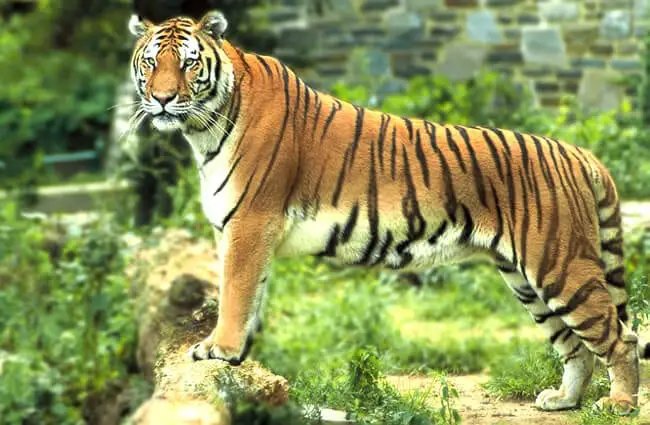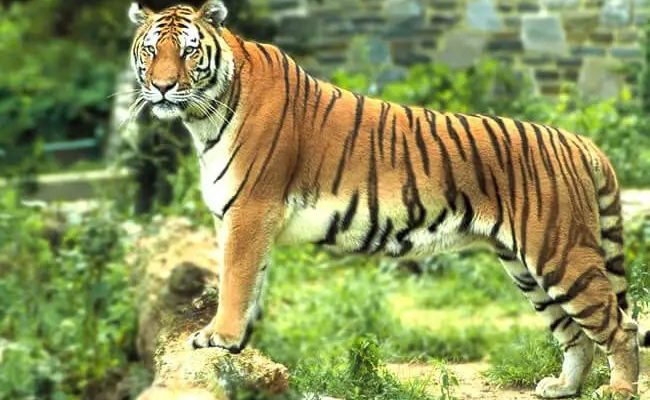
In this guide, we’ll explore ten animals that bear a resemblance to the Bengal tiger. We’ll break down how to identify them, helping you appreciate the unique beauty and characteristics of each species. So, grab a cup of coffee, sit back, and let’s dive into the world of these incredible creatures!
1. Siberian Tiger
The Siberian tiger, also known as the Amur tiger, is perhaps the closest relative to the Bengal tiger. Found primarily in Russia’s Siberian forests, these tigers are known for their striking orange coats that are paler than their Bengal counterparts. One key feature that sets them apart is their thicker fur, which helps them survive in the cold climate.
You might notice that Siberian tigers also have fewer black stripes. This is an adaptation to their snowy habitat, allowing them to blend in with their surroundings. Interestingly, Siberian tigers are also larger on average, with males weighing up to 600 pounds. They are solitary animals, often roaming vast territories in search of prey, just like Bengal tigers do in their environment.
In terms of behavior, both tigers share similar hunting techniques, relying on stealth and power. However, the Siberian tiger has been known to consume larger prey like moose and deer, showcasing its adaptability to different food sources.
2. Indochinese Tiger
Moving to Southeast Asia, we have the Indochinese tiger. These tigers have a darker coat with narrower stripes compared to the Bengal tiger, making them visually distinct. Their range includes countries like Thailand, Vietnam, and Cambodia, where they inhabit dense forests and mountainous regions.
You might wonder how to spot an Indochinese tiger in the wild. Look for their more slender build. They are generally smaller than Bengal tigers, with males weighing around 400 pounds. They are skilled climbers, often seen resting on tree branches. This adaptation helps them evade larger predators and access their prey.
Indochinese tigers are known for their stealth and are primarily nocturnal. They are incredibly agile, making them efficient hunters in their forest habitats.
3. Malayan Tiger
The Malayan tiger is another fascinating relative of the Bengal tiger, primarily found in the forests of Peninsular Malaysia. What sets this tiger apart is its smaller size and distinct patterns. Malayan tigers have a shorter, more compact body, typically weighing around 300 pounds.
Their coat is a rich orange color, similar to the Bengal tiger, but their stripes are thicker and closer together. You might find them in the undulating hills and vibrant jungles, where they primarily hunt deer and wild boar. The Malayan tiger is also known to be a bit more adaptable to various habitats, including plantations and disturbed areas.
Like the Bengal tiger, Malayan tigers are solitary and mainly active at night, showcasing their roles as stealthy hunters in the wild.
4. African Lion
You may be surprised to see the African lion on this list, but they share similarities with Bengal tigers in many ways. While lions and tigers are different species, both are part of the big cat family. African lions live in prides, which is quite different from the solitary nature of tigers.
What you’ll notice first is their majestic manes, which set male lions apart from any tiger. They are also larger than Bengal tigers, with males weighing up to 500 pounds. Lions are social animals, often working together to hunt and protect their territory.
Their habitats range from savannas to grasslands, allowing them to pursue a variety of prey, including zebras and antelopes. While their hunting tactics differ, with lions often using group dynamics, their powerful presence and hunting skills make them similar in some respects to the Bengal tiger.
5. Snow Leopard
The snow leopard might not look much like a Bengal tiger at first glance, but they share habitats in mountainous regions and possess similar hunting techniques. Snow leopards are smaller, with thick fur and long tails, making them perfectly adapted to cold environments in the Himalayas and Central Asia.
What’s fascinating about snow leopards is their ability to leap up to six times their body length, allowing them to navigate rugged terrains with ease. They have a smoky-grey coat patterned with black rosettes, providing excellent camouflage in rocky landscapes.
While they primarily hunt smaller prey such as mountain goats and sheep, their stealth and solitary nature mirror the behavior of the Bengal tiger in many ways. If you think about it, both are masters of their environments, showcasing the beauty of adaptation.
6. Cheetah
Next up is the cheetah, the fastest land animal on the planet. While they may not have the striking stripes of a Bengal tiger, cheetahs share some fascinating similarities. Both species are skilled hunters, relying on stealth in their pursuits. However, cheetahs are built for speed, with lightweight bodies that allow them to sprint at incredible speeds of up to 75 miles per hour for short distances.
Their coats are tawny with black spots, which help them blend into the grasslands where they reside. Unlike Bengal tigers, cheetahs are social animals, often found in smaller groups or family units. They rely on their keen eyesight to spot prey from long distances, and you might notice how they employ a unique hunting strategy, often chasing down antelopes and other swift animals.
Though quite different in many respects, the hunting prowess of cheetahs and Bengal tigers reflects the diverse adaptations of big cats in the wild.
7. Jaguar
The jaguar is a remarkable big cat found in the rainforests of Central and South America. They share a similar size and shape with Bengal tigers, but their appearance is distinct. Jaguars have a solid build, a shorter tail, and a coat covered in rosettes, resembling an innovative work of art crafted by nature.
One notable difference is their powerful bite. Jaguars have one of the strongest bites among big cats, capable of crushing turtle shells and diving underwater for prey. While Bengal tigers primarily hunt on land, jaguars often hunt in trees and water, showcasing their versatility.
Jaguar habitats are lush and diverse, ranging from swamps to rainforests. Both species are solitary hunters, utilizing stealth and skill to stalk and capture prey, making them fascinatingly similar yet unique in their own right.
8. Puma (Cougar)
The puma, often referred to as a cougar or mountain lion, might not share the same grand stature as a Bengal tiger, but they have plenty of similarities. Pumas are agile and adaptable, roaming a variety of landscapes from forests to mountains across North and South America.
What sets pumas apart is their relatively uniform tan coat without distinct markings like stripes or spots. They are also quite versatile in their hunting techniques, preying on everything from deer to smaller animals. You might be surprised to learn that pumas are more solitary than you might expect, often marking their territory and hunting alone.
Both pumas and Bengal tigers share the same stealthy approach to hunting, employing patience and strategy to catch their prey. Their adaptability in different environments showcases the incredible diversity of big cats worldwide.
9. Asian Golden Cat
The Asian golden cat is another fascinating relative to the Bengal tiger, found in the forests of Southeast Asia. Slightly smaller than tigers, these cats have a coat that ranges from golden to reddish-brown. Unlike Bengal tigers, Asian golden cats have more variety in patterns, sometimes appearing solid or with faint spots.
These cats are elusive and mostly solitary, preferring dense forests where they can hunt various prey, including deer and birds. You might notice that their size and behavior closely resemble that of a domestic cat. However, they possess similar hunting skills and adaptability to their environments as Bengal tigers do.
The Asian golden cat might not have the same notoriety as the Bengal tiger, but their fascinating characteristics and elusive nature make them a worthy mention on our list.
10. African Wildcat
Finally, we come to the African wildcat. While they might not be a big cat in the same way as Bengal tigers, these felines share some surprising traits that are worth noting. African wildcats are the ancestors of domestic cats and have a similar appearance to a small tiger, with a tawny coat and faint markings.
They are incredibly adaptable and can thrive in a variety of habitats, from deserts to forests. Their hunting style relies heavily on stealth, similar to how a Bengal tiger would stalk its prey. African wildcats primarily hunt small mammals and birds, showcasing the diverse strategies employed by different felines.
Though much smaller than a Bengal tiger, the African wildcat reminds us of the shared traits among all cats and how evolution shapes their adaptations to survive in the wild.
Exploring the world of animals similar to the Bengal tiger reveals a captivating tapestry of adaptations and characteristics. From the majestic Siberian tiger to the elusive Asian golden cat, each of these creatures offers a glimpse into the richness of biodiversity. While they may share certain traits with Bengal tigers, every animal on this list has its unique story, behavior, and habitat.
Understanding these similarities not only deepens our appreciation for these magnificent creatures but also highlights the importance of conservation efforts to protect their habitats and ensure their survival. So next time you encounter a Bengal tiger or any of its distant relatives, take a moment to marvel at the incredible diversity of the animal kingdom!

